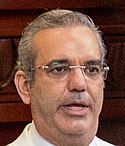2016_Dominican_Republic_general_election
2016 Dominican Republic general election
Election in the Dominican Republic
General elections were held in Dominican Republic on 15 May 2016 to elect a president, vice-president and the Congress, as well as 20 deputies to the Central American Parliament, municipal councils, mayors and vice mayors.[1][2] On 15 May 2015 Roberto Rosario, president of the Central Electoral Board, said that there would be about 4,300 seats up for election in the "most complex elections in history".[3]
You can help expand this article with text translated from the corresponding article in Spanish. (May 2016) Click [show] for important translation instructions.
|


